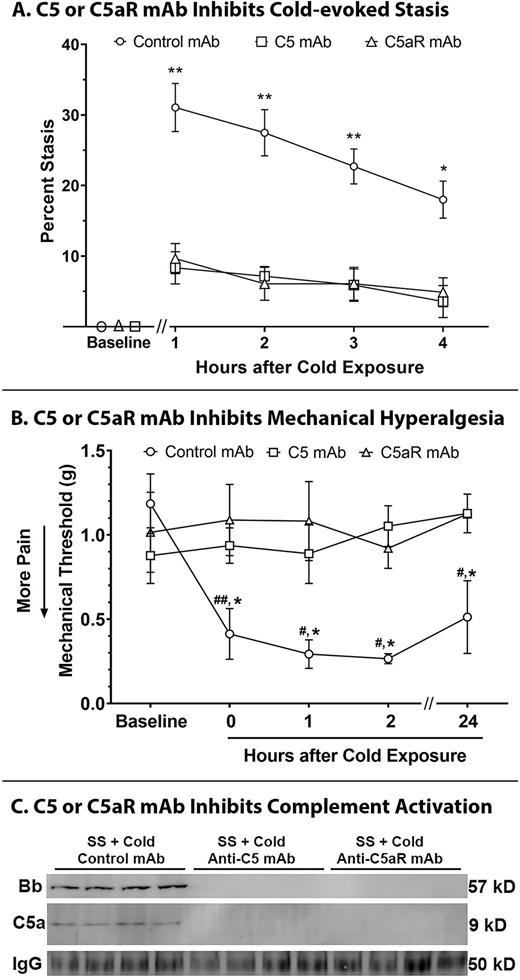Abstract
BACKROUND AND AIM: Vaso-occlusive crises (VOC) cause severe pain in patients with sickle cell disease (SCD). To date, epidemiological studies have shown seasonably colder temperatures exacerbate SCD-related pain. Although literature and clinical observations suggest a connection between cold and triggering of acute VOC pain, the biologic mechanisms underlying VOC-evoked pain in SCD patients are poorly understood. Repeated cold or painful events results in vasoconstriction and decreased perfusion, which increases red cell transit time, deoxygenation, and hemoglobin S polymerization [Veluswamy et al. Blood. 2020;136:1191]. SCD mice exhibit ischemia-reperfusion (I/R) pathophysiology in response to hypoxia-reoxygenation with a concomitant increase in hyperalgesia, inflammation, and complement activation. Because complement activation plays a crucial role in animal pain models, we used a new model of cold-evoked VOC and I/R in HbSS mice to examine complement C5a/C5aR signaling as a mechanistic link between vaso-occlusion and acute pain in SCD.
MATERIALS AND METHODS: We used a dorsal skinfold chamber model to measure microvascular stasis (vaso-occlusion) and von Frey filaments applied to the plantar surface of the hind paws to assess mechanical hyperalgesia (pain) in Townes HbSS and control HbAA mice. Non-hyperalgesic mice were exposed to cold (10oC/50oF) for 1 hour (h) and then returned to room temperature. Measurements of VOC and paw withdrawal threshold were collected at baseline before cold and at 1-4 h after cold exposure. After the 4 h stasis measurement, mice were sacrificed, and livers removed and frozen. Hepatic microsomes and nuclear extracts were isolated by differential centrifugation and liver inflammation markers were assessed on Western blots. Hepatic nuclear extracts were blotted with antibodies to NF-ĸB phospho-p65 and total p65. Hepatic microsomes were blotted with antibodies to VCAM-1 and ICAM-1. Plasma samples were blotted with antibodies to alternative pathway factor B activation fragment Bb and complement anaphylatoxin C5a. To examine the role of complement activation in stasis and hyperalgesia produced by cold-evoked VOC, HbSS mice were infused 30 minutes before cold exposure with an inhibitory monoclonal antibody (mAb) to murine C5 to prevent C5 cleavage or C5aR to prevent C5a binding to C5aR and subsequent C5a/C5aR signaling, or a control mAb (1.2 mg/kg body weight).
RESULTS: Cold exposure induced more microvascular stasis (vaso-occlusion), 1, 2, 3, and 4 h after cold exposure in subcutaneous venules of HbSS mice as compared to HbAA mice exposed to cold and HbSS mice left at room temperature (p<0.001). Cold exposure also evoked mechanical hyperalgesia in HbSS mice 1, 2, and 24 h after cold as compared to baseline prior to cold (p<0.01) and cold exposed HbAA mice (p<0.05). Vaso-occlusion and mechanical hyperalgesia were accompanied by an increase in Bb and C5a levels in the plasma of HbSS, but not HbAA mice 4 h after cold exposure (p<0.01). In addition, there was an increase in NF-κB activation and VCAM-1 and ICAM-1 adhesion molecule expression in the livers of HbSS mice after cold as compared to HbAA mice exposed to cold and HbSS mice unexposed to cold (p<0.01). Importantly, pretreatment of HbSS mice before cold exposure with a blocking mAb to C5 or C5aR inhibited vaso-occlusion (Figure 1A), mechanical hyperalgesia (Figure 1B), and complement activation (Figure 1C) as compared to cold-exposed HbSS mice treated with a control mAb.
CONCLUSION: This mouse model of cold-evoked VOC provides an opportunity to examine potential mediators between vaso-occlusion and pain in SCD. Our results demonstrate that in response to cold temperatures, complement activation contributes to vaso-occlusion and acute hyperalgesia, suggesting a linkage between complement activation, vaso-occlusion, and pain during cold-induced VOC. These studies provide a rationale for clinical use of complement inhibitors to prevent and treat pain in SCD.
Disclosures
Belcher:CSL-Behring: Research Funding; Mitobridge-Astellas: Research Funding; Omeros: Research Funding. Gupta:Novartis: Honoraria, Research Funding; CSL Behring: Honoraria; Cyclerion: Research Funding; 1910 Genetics: Research Funding; Grifols: Research Funding; Zilker LLC: Research Funding; UCI Foundation: Research Funding; SCIRE Foundation: Research Funding; Tautona Group: Honoraria. Vercellotti:CSL-Behring: Research Funding; Mitobridge-Astellas: Research Funding; Omeros: Research Funding.
Author notes
Asterisk with author names denotes non-ASH members.


This feature is available to Subscribers Only
Sign In or Create an Account Close Modal